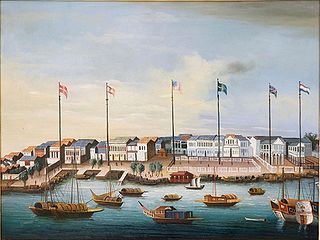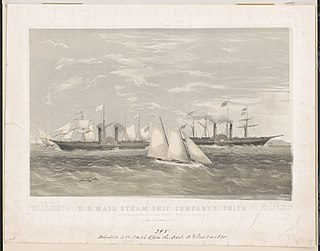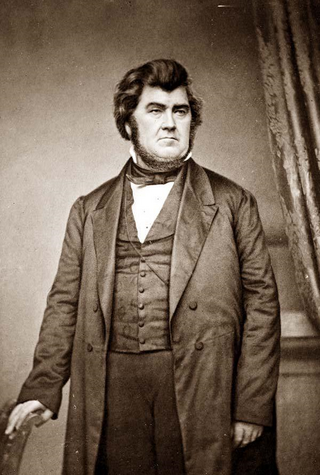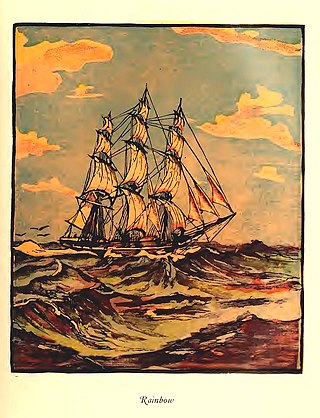
A clipper was a type of mid-19th-century merchant sailing vessel, designed for speed. Clippers were generally narrow for their length, small by later 19th-century standards, could carry limited bulk freight, and had a large total sail area. "Clipper" does not refer to a specific sailplan; clippers may be schooners, brigs, brigantines, etc., as well as full-rigged ships. Clippers were mostly constructed in British and American shipyards, although France, Brazil, the Netherlands, and other nations also produced some. Clippers sailed all over the world, primarily on the trade routes between the United Kingdom and China, in transatlantic trade, and on the New York-to-San Francisco route around Cape Horn during the California Gold Rush. Dutch clippers were built beginning in the 1850s for the tea trade and passenger service to Java.

APL, formerly called American President Lines Ltd., is an American container shipping company that is a subsidiary of French shipping company CMA CGM. It operates an all-container ship fleet, including nine U.S. flagged container vessels.
The Forbes family is one of the components of the Boston Brahmins—a wealthy extended American family long prominent in Boston, Massachusetts. The family's fortune originates from trading opium and tea between North America and China in the 19th century plus other investments in the same period. The name descends from Scottish immigrants and can be traced back to Sir John de Forbes in Scotland in the 12th century. Family members include businessman John Murray Forbes (1813–1898), part of the first generation who accumulated wealth, and politician John Forbes Kerry.

The Pacific Mail Steamship Company was founded April 18, 1848, as a joint stock company under the laws of the State of New York by a group of New York City merchants. Incorporators included William H. Aspinwall, Edwin Bartlett, Henry Chauncey, Mr. Alsop, G.G. Howland and S.S. Howland.

The Old China Trade refers to the early commerce between the Qing Empire and the United States under the Canton System, spanning from shortly after the end of the American Revolutionary War in 1783 to the Treaty of Wanghia in 1844. The Old China Trade represented the beginning of relations between the United States and East Asia, including eventually U.S.–China relations. The maritime fur trade was a major aspect of the Old China Trade, as was illegal trafficking in opium. The trade era overlapped the First Opium War, which resulted from an attempt by China to enforce its prohibition on opium smuggling by Western traders and blockade-runners.

Abiel Abbot Low was an American entrepreneur, businessman, trader and philanthropist who gained most of his fortune from the China trade, importing teas, porcelains, and silk, and building and operating a fleet of reputable clipper ships.

Augustine Heard & Co. was a major nineteenth-century American trading firm in Qing dynasty China whose operations consisted in importing and exporting a large array of goods, including tea and opium.

Sea Witch was an American clipper ship designed by naval architect John W. Griffiths for the China trading firm of Howland & Aspinwall. She was launched at Smith & Dimon in Manhattan on December 8, 1846.

William Henry Aspinwall was a prominent American businessman who was a partner in the merchant firm of Howland & Aspinwall and was a co-founder of both the Pacific Mail Steamship Company and Panama Canal Railway companies which revolutionized the migration of goods and people to the Western coast of the United States.

U.S. Mail Steamship Company was a company formed in 1848 by George Law, Marshall Owen Roberts and Bowes R. McIlvaine to assume the contract to carry the U. S. mails from New York City, with stops in New Orleans and Havana, to the Isthmus of Panama for delivery in California. The company had the SS Ohio and the SS Georgia built in 1848, and with the purchased SS Falcon in early 1849 carried the first passengers by steamship to Chagres, on the east coast of the Isthmus of Panama. Soon the rapid transit time the steamship lines and the trans isthmus passage made possible when the California Gold Rush began made it a very profitable company.

George Law was an American entrepreneur and failed presidential candidate for the American Party in the 1856 United States presidential election from New York.

Robert H. Waterman, known as Bully Waterman or Bully Bob Waterman, was an American merchant sea captain. He set three sailing speed records; his time of 74 days from Hong Kong to New York City has never been bettered in a sail-powered vessel. He was reputed as a martinet, and was once convicted of assault against a crewman in a controversial California criminal case.

Rainbow, launched in New York in 1845 to sail in the China trade for the firm Howland & Aspinwall, was a clipper, a type of sailing vessel designed to sacrifice cargo capacity for speed.

SS California was one of the first steamships to steam in the Pacific Ocean and the first steamship to travel from Central America to North America. She was built for the Pacific Mail Steamship Company which was founded April 18, 1848 as a joint stock company in the State of New York by a group of New York City merchants: William H. Aspinwall, Edwin Bartlett, Henry Chauncey, Mr. Alsop, G.G. Howland and S.S. Howland. She was the first of three steamboats specified in a government mail contract to provide mail, passenger, and freight service from Panama to and from San Francisco and Oregon.

Warren Delano Jr. was an American merchant and drug smuggler who made a large fortune smuggling illegal opium into China. He was the maternal grandfather of U.S. President Franklin Delano Roosevelt.

John Lloyd Aspinwall was an American lawyer and soldier who served in the U.S. Civil War, achieving the rank of brigadier general in the U.S. National Guard.
Meredith Howland was an American soldier and clubman who was prominent in New York society during the Gilded Age.
Gardiner Greene Howland was a prominent American businessman who was a founding partner in the merchant firm of Howland & Aspinwall and a co-founder of the Pacific Mail Steamship Company.
Samuel Shaw Howland was a prominent American businessman who was a founding partner in the merchant firm of Howland & Aspinwall and an incorporator of the Pacific Mail Steamship Company.
















